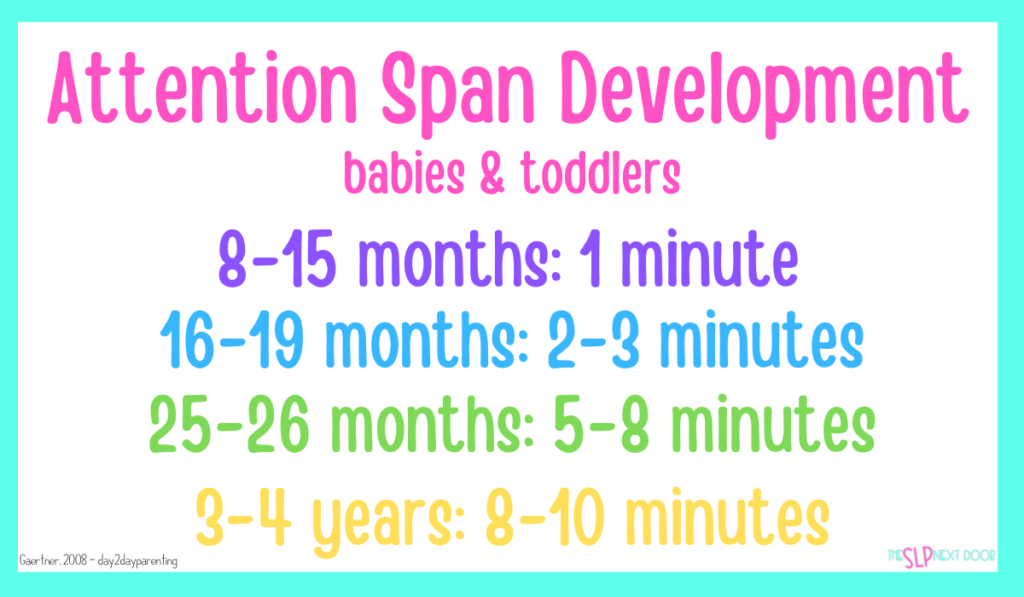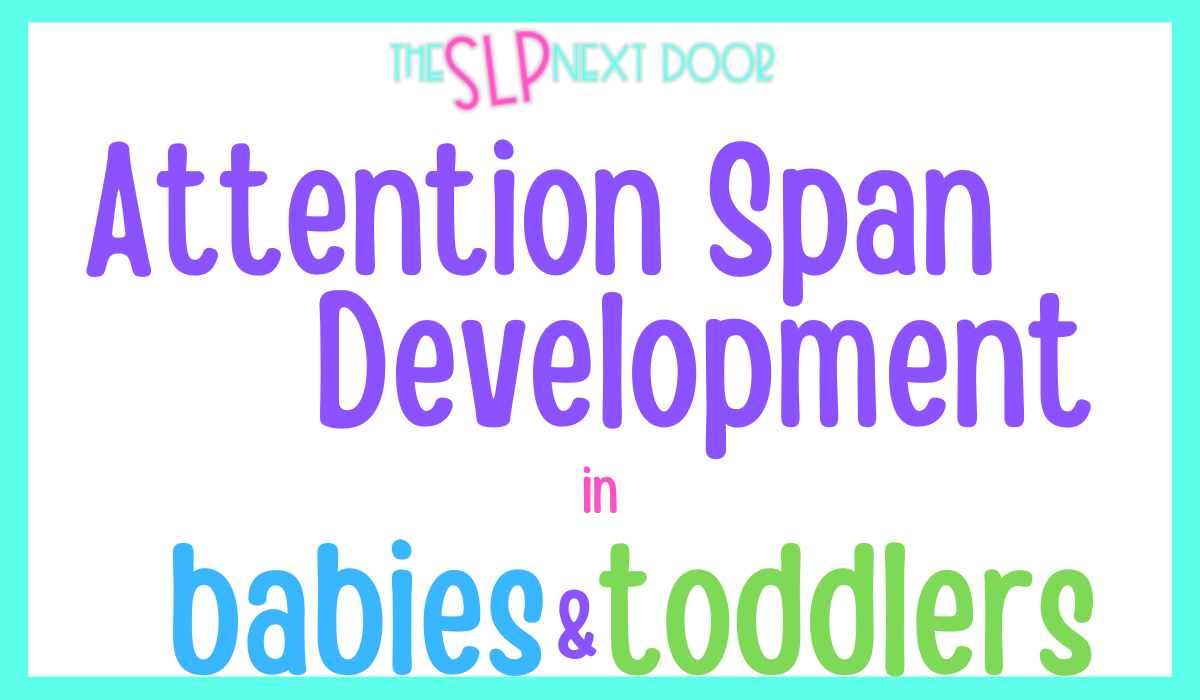Miriam-Webster Dictionary defines attention span as “the length of time during which one (such as an individual or a group) is able to concentrate or remain interested”
The key to increasing attention to task in speech therapy for toddlers is to remember that progress doesn’t always happen in a straight line, and a toddler’s ability to attend to tasks increases over time.
Attention span development will look different for children with developmental delays or communication difficulties. (aka- the ones on your caseload) They’ll need even more flexibility and support to stay engaged.
Do Infants Pay Attention?
Yes! Attention span begins developing from birth. Studies have shown that babies can recognize and attend to sounds inside a mother’s womb. Attention during infancy tends to focus more on developing social skills. Babies will begin to look in the direction of caregivers, babble and interact with others around them, and notice and play with toys purposefully throughout their first year.
We also know that during their first year, babies are startled by loud noises and begin paying more attention to sounds/activities in their environment.
Attention Span Development 1-2 Years
8-15 months: Around a year old, babies begin to engage in a preferred toy or activity for about 1-2 minutes before switching to another activity. Sometimes, attention to task is shortened because the babies become distracted by a noise that disrupts their play.
16-19 months: Anyone who’s spent enough time with an 18-month-old knows they don’t spend much time on a specific task before becoming distracted. However, they can engage in the activity for up to 3 minutes when they are really interested in something.
20-24 months: At 2 years old, attention span increases up to 6 minutes. Toddlers may still become distracted by some sounds in the environment. However, you might begin to notice that your words don’t seem to interrupt their play. (which is also a nice way of saying they’re starting to ignore you… yay for growth & development!)

Attention Span Development 2-4 Years
25-36 months: By 3 years old, toddlers can attend to a task for up to 8 minutes. They also begin to show the ability to shift their attention from an adult talking to them back to their activity. For example, when you say something like “Come see me!” they may look up at you, respond, then go right back to playing. Next time you find yourself frustrated they aren’t listening- it may be a milestone! Yay progress!
By the time a preschooler turns 4 years old we can expect an average, typically developing child to attend to a task up to 10 minutes. They may pay attention to you and their activity simultaneously. In other words, they may be engaged in a task, notice your existence, offer a response, and continue with the activity they’re engaged in.
Activities to Increase Attention Span
Here are a few ideas to keep in mind
- Follow their lead. Play-based, child-led sessions are important with this population. Let them guide (not control) the session based on what interests them. If they’re drawn to a particular toy or activity, use it as an opportunity to integrate language and communication goals into natural play.
- Short bursts of engagement. I tell therapists (and parents) all the time, “If we get 5-10 minutes of focus out of this 30 minutes together, it’s been a successful day,” especially for the youngest of toddlers. Plan for quick, engaging activities that fit their interests and are within their attention span. It’s not about getting them to sit still but making the most of those small windows of focus. BTW, this also means that a toddler may complete part of a task (like putting one piece of a puzzle back), run around the room (or grab a snack), and then come back to the puzzle.
- Incorporate movement. If they’re on the move, join them! Use active play to build language skills. For example, narrate what they’re doing or hide puzzle pieces in the room for them to find and put back together.
- Keep activities varied. If you’re having trouble gaining a toddler’s attention, change things up until you find their interest. You may also rotate through a mix of activities to keep them engaged while keeping them (and you) from getting bored.
- Side note: if you find something that works, don’t be afraid to stick with it for as long as possible. The truth is that you can target a ton of language using the same toy or book. Don’t feel pressured to “need something new every session.”
- Be patient with progress. Progress will look different for every child, especially if they have developmental delays. Celebrate the small wins, whether it’s a few extra seconds of focus, replacing 2-3 puzzle pieces instead of 1, or a new word used during play.
You’ve Got This!
Even when it feels like a toddler’s attention is everywhere but where you think it should be, by being intentional with your activities and language, you’re still doing amazing work. Toddlers are amazing at soaking up so much information, even in those brief moments of focus.

Looking to learn more about attention span development and other developmental milestones for early intervention speech and language? Check out my SLP early intervention handbook! It’s the perfect attention to your speech therapy for toddlers!



3 Responses